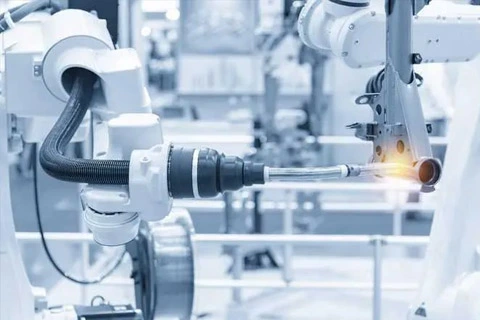General Robotics

The robotics industry includes standards that cover guidelines, applications, and more.
UL 1740 Ed. 4-2018
Standard for Robots and Robotic Equipment
This revision of ANSI/UL 1740 dated June 20, 2019 is being issued to editorially correct a reference to ISO 10218-1 in paragraph 1.1. No technical changes have been made. Text that has been changed in any manner or impacted by UL's electronic publishing system is marked with a vertical line in the margin.
IEEE 1872-2015
IEEE Standard Ontologies for Robotics and Automation
A core ontology that specifies the main, most general concepts, relations, and axioms of robotics and automation (R&A) is defined in this standard, which is intended as a reference for knowledge representation and reasoning in robots, as well as a formal reference vocabulary for communicating knowledge about R&A between robots and humans. This standard is composed of a core ontology about R&A, called CORA, together with other ontologies that give support to CORA.
RIA TR R15.106-2006
Teaching Multiple Robots
The purpose of this technical report is to provide interpretation of certain provisions of ANSI/RIA R15.06-1999 and to present examples of current industry practices for teaching (programming) multiple industrial robots that share a common safeguarded space. This information is in addition to the requirements contained in ANSI/RIA R15.06-1999 and the committee considers the examples to comply with the safety standard.
ISO 18646-1:2016
Robotics - Performance criteria and related test methods for service robots - Part 1: Locomotion for wheeled robots
ISO 18646-1:2016 describes methods for specifying and evaluating the locomotion performance of wheeled robots in indoor environments.
ISO 18646-2:2019
Robotics - Performance criteria and related test methods for service robots - Part 2: Navigation
This document describes methods of specifying and evaluating the navigation performance of mobile service robots. Navigation performance in this document is measured by pose accuracy and repeatability, as well as the ability to detect and avoid obstacles. Other measures of navigation performance are available but are not covered in this document.
The criteria and related test methods are applicable only to mobile platforms that are in contact with the travel surface. For evaluating the characteristics of manipulators, ISO 9283 applies.
This document deals with indoor environments only. However, the depicted tests can also be applicable for robots operating in outdoor environments, as described in Annex A.
This document is not applicable for the verification or validation of safety requirements. It does not deal with safety requirements for test personnel during testing.
ANSI/RIA R15.05-1-1990 (R1999)
Evaluation of Point-to-Point and Static Performance Characteristics of Industrial Robots and Robot Systems
Facilitates understanding between manufacturers and users of industrial robots. Defines the most important performance criteria and method for evaluating these criteria. Provides meaningful technical information that robot users can utilize for the selection of the proper robot for their specific application.
ANSI/RIA R15.05-2-1992 (R1999)
Industrial Robots and Robot Systems - Path-Related and Dynamic Performance Characteristics - Evaluation
Facilitates understanding between manufacturers and users of industrial robots. Defines the fundamental dynamic path-related performance characteristics and provides a method quantify dynamic performance. Provides meaningful technical information that robot users can utilize for the selection of the proper robot for their specific application. Provides information that can facilitate the comparison of the performance of different robots.
ANSI/RIA R15.05-3-1992 (R1999)
Industrial Robots and Robot Systems - Reliability Acceptance Testing - Guidelines
Provides the minimum (reproducible) testing requirements that will qualify a newly manufactured or a newly rebuilt industrial robot to be placed into use without additional infant mortality testing.
RIA TR R15.506-2014
Applicability of ANSI/RIA R15.06-2012 for Existing Industrial Robot Applications
TR 506 explains how to take the 2012 R15.06 standard into account for existing robot systems, rather than the all-new robot installation that is the primary topic of the 2012 R15.06. The TR 506 document as published in 2014 continues to be the current active version.
ISO/TS 15066:2016
Robots and robotic devices - Collaborative robots
ISO/TS 15066:2016 specifies safety requirements for collaborative industrial robot systems and the work environment, and supplements the requirements and guidance on collaborative industrial robot operation given in ISO 10218‑1 and ISO 10218‑2.
ISO/TS 15066:2016 applies to industrial robot systems as described in ISO 10218‑1 and ISO 10218‑2. It does not apply to non-industrial robots, although the safety principles presented can be useful to other areas of robotics.
NOTE This Technical Specification does not apply to collaborative applications designed prior to its publication.

ISO 9787:2013
Robots and robotic devices - Coordinate systems and motion nomenclatures
ISO 9787:2013 defines and specifies robot coordinate systems. It also provides nomenclature, including notations, for the basic robot motions. It is intended to aid in robot alignment, testing, and programming.
ISO 9787:2013 applies to all robots and robotic devices as defined in ISO 8373.
ISO 9283:1998
Manipulating industrial robots - Performance criteria and related test methods
This International Standard describes methods of specifying and testing the following performance characteristics of manipulating industrial robots:
- pose accuracy and pose repeatability;
- multi-directional pose accuracy variation;
- distance accuracy and distance repeatability;
- position stabilization time;
- position overshoot;
- drift of pose characteristics;
- exchangeability;
- path accuracy and path repeatability;
- path accuracy on reorientation
- cornering deviations;
- path velocity characteristics;
- minimum posing time;
- static compliance;
- weaving deviations.
This International Standard does not specify which of the above performance characteristics are to be chosen for testing a particular robot. The tests described in this International Standard are primarily intended for developing and verifying individual robot specifications, but can also be used for such purposes as prototype testing, type testing or acceptance testing.
To compare performance characteristics between different robots, as defined in this International Standard, the following parameters have to be the same: test cube sizes, test loads, test velocities, test paths, test cycles, environmental conditions.
Annex A provides parameters specific for comparison testing of pose-to-pose characteristics and path characteristics.
This International Standard applies to all manipulating industrial robots as defined in ISO 8373. However, for the purpose of this International Standard the term “robot” means manipulating industrial robot.

ISO 9409-1:2004
Manipulating industrial robots - Mechanical interfaces - Part 1: Plates
ISO 9409-1:2004 defines the main dimensions, designation and marking for a circular plate as mechanical interface. It is intended to ensure the exchangeability and to keep the orientation of hand-mounted end effectors.
It does not define other requirements of the end effector coupling device.
It does not contain any correlation of load-carrying ranges, as it is expected that the appropriate interface is selected depending on the application and the load-carrying capacity of the robot.

ISO 9409-2:2002
Manipulating industrial robots - Mechanical interfaces - Part 2: Shafts
ISO 9409-2:2002 defines the main dimensions, designation and marking for a shaft with cylindrical projection as mechanical interface. It is intended to ensure the exchangeability and to keep the orientation of hand-mounted end effectors.
ISO 9409-2:2002 does not contain any correlation of load-carrying ranges.
The mechanical interfaces specified in ISO 9409-2:2002 will also find application in simple handling systems which are not covered by the definition of manipulating industrial robots, such as pick-and-place or master-slave units.

ISO 9946:1999
Manipulating industrial robots -- Presentation of characteristics
This International Standard specifies how characteristics of robots shall be presented by the manufacturer.

ISO/TR 13309:1995
Manipulating industrial robots - Informative guide on test equipment and metrology methods of operation for robot performance evaluation in accordance with ISO 9283
Supplies information on the state-of-the-art of test equipment operating principles. Additional information is provided that describes the applications of current test equipment technology to ISO 9283.

